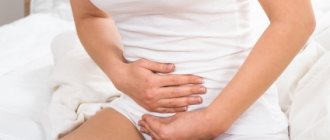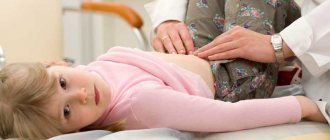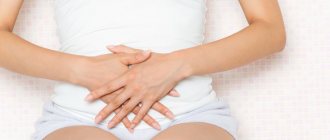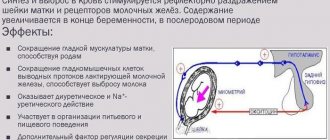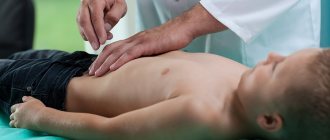Not all women keep a schedule by which they can track the regularity and duration of their periods. Most of them quite accurately predict the start date of their next menstruation based on changes in their well-being due to physiological reasons. Pain, discomfort in the lower abdomen, and general malaise two or three days before the onset of menstruation become almost commonplace. Is it necessary to pay attention to the intensity and nature of unpleasant symptoms, depending on the woman’s overall health, hormonal balance indicators, cyclical changes in the organs of the reproductive system, and the severity of premenstrual syndrome? Moderate discomfort felt by a woman before her period is considered physiologically normal. But spasmodic acute pain and noticeable discomfort that are present before menstruation and do not subside with the onset of menstruation should alert every woman and become the basis for visiting a gynecologist.
Severe pain before menstruation or the onset of menstruation does not mean anything good.
Severe throbbing, sharp or cramping pain in the lower abdomen, left or right abdomen, when there is severe stabbing, aching or pulling in the abdomen before the onset of menstruation, this is most often a sign of pathology. Of course, if you have a severe pain in the lower abdomen before your period, you cannot exclude the possibility of a physiological cause (not dangerous to health). Further in the article, we will go into detail about what diseases there may be if the lower abdomen, left or right abdomen hurts very badly, what diseases there may be if there is very severe pain and symptoms of PMS before menstruation.
Causes of severe abdominal pain before menstruation
How to distinguish normality from pathology, because each woman has her own individual pain threshold. How to understand when abdominal pain during PMS is normal, and when severe pain in the lower abdomen on the left or right is symptoms of a pathological problem or disease. Severe pain before the onset of menstruation can be interpreted in different ways, depending on how much the woman feels the deterioration of her general condition. The body of women with a low pain threshold cannot cope with even mild pain and needs to take painkillers, but there are women who continue to live and work as usual, despite the presence of intense pain, patiently enduring them and not taking any measures. This situation confuses doctors when they hear complaints of severe pain before menstruation, so they focus on a complex of all symptoms.
The most common symptoms of the onset of premenstrual syndrome are nagging and aching pain in the lower abdomen, which can radiate to the left or right side; sometimes pain in the lower abdomen before menstruation can radiate to the lower back, lower groin, pubic area or tailbone area. But such pain before the onset of menstruation should not be severe; ideally, a woman should feel mild discomfort or moderate pain. A number of factors can negatively affect a woman’s well-being on the eve of her next menstruation:
- Excessive levels of physical exertion due to demanding work conditions or intense workouts in the gym, especially on weight machines, can cause very severe abdominal pain. Sometimes, after serious training, a woman may feel literally unbearable pain in her stomach if her period is about to begin. Strength training before your period often increases soreness, pain, and other symptoms of PMS (premenstrual syndrome).
- The reasons for increased pain before menstruation may lie in staying for a long time in cold conditions, leading to hypothermia. Due to the fact that the body gets cold, especially the legs, spasms may occur in the vessels of the pelvic organs, which increase the sensation of pain on the eve of menstruation. So, before menstruation, habitual and mild pain in the abdomen can turn into a very mild nagging or aching pain in the abdomen.
- Why do abdominal pains only get worse before menstruation? Premenstrual tension syndrome, or more simply, premenstrual syndrome (PMS). Not everyone experiences an uncomfortable state a couple of days before the start of menstruation; in some women it is felt much earlier, 5-7 days. Characteristic symptoms are dull nagging pain in the lower abdomen combined with autonomic and neurological symptoms (tachycardia, headache, sweating, numbness of the extremities). PMS is classified not as a separate pathology, but as a separate symptom complex with different clinical forms, depending on the severity of manifestations that can disrupt the usual lifestyle and limit a woman’s ability to work.
- What could happen if during these periods your stomach hurts much more than usual before menstruation? Lack of sufficient physical activity. Physical inactivity, caused by the “sedentary” principle of work and inactive rest, contributes to the development of blood supply disorders to the pelvic organs and leads to stagnation. This provokes an increase in pain, abdominal pain becomes more noticeable on the eve of menstruation.
- Excess body weight causes a lot of problems in the body, just some of them are delayed menstruation or early menstruation, too much or very scanty discharge during menstruation, very severe abdominal pain before the onset of menstruation. Little known to many is the fact that adipose tissue itself performs, among other things, an endocrine function, that is, it releases hormones, such as estrogen, into the bloodstream. A significant excess of adipose tissue can significantly affect the balance of hormonal levels, and hormonal imbalances often accompany painful menstruation.
- Diseases of the digestive system can cause very painful premenstrual syndrome. Due to pathologies of the stomach and intestines, cramps and bloating (flatulence) are often observed; irritated intestinal loops put pressure on the area of the uterus and appendages, increasing the pain during menstruation.
- Use of an intrauterine device (IUD). For some women, the IUD is an undesirable form of contraception, since it can become one of the causes of dysmenorrhea. If, after installing various types of intrauterine devices, a woman has pain in the lower abdomen and the pain does not go away, if such pain in the lower abdomen after the installation of PMS is regular and appears periodically, you should definitely seek help from a doctor.
- A number of gynecological pathologies, especially those related to the condition of the uterus. Pain of varying intensity can occur against the background of pathological changes in the muscular uterine tissues or with an abnormal anatomical structure, which negatively affects the contractility of the organ or the free outflow of menstrual fluid. This is the presence in the tissues of the uterus of myomatous nodes that deform the uterine cavity, underdevelopment of its structure, narrowing of the cervical canal, displaced location in the pelvic area, endometriotic proliferation of the uterine epithelium outside the boundaries of the organ. All these deviations provoke different pain sensations before the onset of menstruation and during menstruation.
- Consequences of gynecological surgical interventions, complicated course of the postpartum period. Scarring and other changes in the tissues of the genital organs, especially the uterus and appendages, after surgery can cause premenstrual pain.
- Inflammatory processes in the organs of the genitourinary system. Closer to the beginning of menstruation, chronic pyelonephritis, cystitis and other diseases that intensify premenstrual pain syndrome often worsen.
The debatable question of whether premenstrual pain can occur in completely healthy women is resolved by the general opinion of experts that their physiological nature is manifested in low intensity and vagueness of the pain syndrome. The presence of cutting, sharp, spasmodic pain before the onset of menstruation is a reason to look for the cause in gynecological or other pathology.
Ectopic pregnancy
The egg is fertilized in the fallopian tube, and then descends into the uterus and implants into the wall of the organ. But sometimes attachment occurs not in the uterus, but in an organ that is not adapted for this - then an ectopic pregnancy occurs.
Causes
Difficulty in the passage of the fertilized egg through the fallopian tubes may be caused by:
- obstruction;
- the presence of pathological narrowings;
- inability of the walls of the reproductive organ to attach a fertilized egg (implantation occurs in the cervix).
Unable to gain a foothold in the reproductive organ, the fertilized egg implants into the fallopian tube or uterine cervix, and less often into other organs that are also unsuitable for bearing a child.
Symptoms
Ectopic pregnancy is characterized by:
- cramping pain in the lower abdomen before menstruation;
- the appearance of heavy bleeding against the background of intensified contractions.
During tubal implantation, there is additional pain on the right or left (at the site of embryo attachment).
Almost always, symptoms develop after a missed period and the woman already knows about pregnancy. But, unfortunately, with the help of the test it is possible to determine only the fertilization that has occurred, and not the place of implantation of the embryo, and during an external examination it is impossible to distinguish an ectopic pregnancy from a miscarriage.
Help
Doctors decide what to do in a hospital setting. The cervical implant comes out on its own under medical supervision or is removed by cleaning the reproductive organ under local anesthesia.
With tubal insertion, spontaneous evacuation is impossible, and cramping pain can lead to rupture of the fallopian tube . In this case, abdominal surgery or endoscopic removal of the tube along with the embryo is performed.
Where to contact
If your period is heavy, accompanied by severe cramping pain, you must call an ambulance. Doctors will take you to the emergency department of a gynecological hospital.
Diagnosis of very severe pain, how to determine the cause of unbearable abdominal pain
The causes of premenstrual pain can be clarified based on the results of a thorough examination. To complete the clinical picture, the doctor needs to have information:
- about the nature, regularity, intensity of pain;
- about the presence of accompanying symptoms;
- about the methods of contraception used by the patient;
- about previous diagnoses, if inflammatory gynecological diseases and methods of their treatment were previously identified;
- about the nature of the manipulations and surgical interventions previously performed on the patient (diagnostic curettage, hysteroscopy, abortion, course of the postpartum period).
Laboratory tests include:
- general and biochemical analysis of blood, urine, vaginal smears, scrapings from the surface of the cervix;
- bacterial culture, enzyme-linked immunosorbent assay, PCR method for identifying infectious agents if there is reason that pain may be a consequence of an infectious disease.
The condition of the uterus, appendages, and fallopian tubes can be judged by the results of ultrasound diagnostics, which helps to identify signs of inflammatory processes, as well as the presence of neoplasms in these organs (cysts, fibroids, fibroids). Using an ultrasound examination, the doctor can assess the condition of the fallopian tubes, identify narrowing of the cervical canal, the presence of scar tissue and adhesions. If the gynecologist does not find any reason to explain the presence of severe painful premenstrual syndrome, the woman is recommended to visit other doctors (endocrinologist, gastroenterologist, neurologist). You need to be patient, because diagnostic procedures may take one or two months, but you cannot retreat, since this is the only way to identify the original source of pain before the onset of menstruation.
The nature of pain during PMS, types and types of pain
The physiological course of PMS in most cases is not markedly painful. The tension that arises in the lower abdomen does not have a specific localization, and sensations of vague pain appear. With physical activity or as a result of a change in posture, they do not intensify, but remain at the same level. PMS pain is accompanied by other symptoms, including:
- weakness, drowsiness;
- increased irritability;
- mood swings;
- increased sensitivity in the mammary glands;
The frequency of such symptoms is clearly traceable in accordance with the menstrual cycles, starting mainly 3-5 days before the start of the next menstruation. With the pathological nature of PMS, its symptoms are noted not only on the eve of menstruation, but also during different phases of the monthly cycle. Pain before menstruation is more intense and often radiates to the lumbosacral and gluteal region. It is poorly controlled with analgesics.
As for very strong, cutting pain with a clear localization, when the patient is looking for a comfortable position to relieve them, this indicates another pathology, but not premenstrual pain syndrome. It is necessary to differentiate such pain from symptoms of acute inflammation of the appendix, torsion of the appendix, or rupture of a cystic formation or fallopian tube. Only a doctor can do this, so in such situations it is better for the patient to call an ambulance.
Why does colitis occur during ovulation?
Tingling in the uterus may occur during ovulation. Ovulation is a biological process during which an egg is released from the follicle, prepared for fertilization. Ovulation is a stage of the menstrual cycle, its rhythm is changeable. The violation is observed in different cases, it occurs during abortion. In this situation, the female body undergoes changes within 4 months. Disruption of ovulation rhythm after childbirth lasts up to 1 year.
You need to know that ovulation changes before menopause. When the egg leaves the follicle, the woman experiences vaginal discharge, in addition to this, fluctuations in basal temperature are observed (today it is low, tomorrow it is high). When the ovulation rhythm is disrupted, the amount of progesterone increases.
The release of the egg also changes when there is inflammation in the genitals, the functioning of the adrenal glands is disrupted, and the thyroid gland is not functioning well. Disturbances are observed with neoplasms of the pituitary gland and when the body is under stress. In some cases, ovulation leads to menstrual irregularities and amenorrhea. Amenorrhea is the absence of menstruation for 5-6 months. It is important to know: a change in ovulation may be a sign of bleeding in the uterine cavity.
What to do, how to treat very severe pain before menstruation
What needs to be done to determine the reason why your stomach hurts before your period and the nagging or aching pain does not stop? First of all, you need to visit a gynecologist if there is a clear correlation between the appearance of pain before the onset of menstruation. The results of the gynecological examination, data from the collected medical history and laboratory tests will determine the further course of action. It is possible that you will need to consult an endocrinologist, neurologist, gastroenterologist, or psychiatrist.
Drug treatment of premenstrual pain should be avoided until diagnostic results and doctor's recommendations are received. Identified endocrine abnormalities in the functioning of the ovaries, adrenal glands, and thyroid glands require correction with hormonal drugs, a treatment regimen for which can only be prescribed by a doctor. Additionally, vitamin therapy is prescribed, which is carried out with oral or injectable medications, or with the help of dietary supplements.
Inflammatory problems can be solved by taking antibiotics or antibacterial agents prescribed by the gynecologist. What to do if pain occurs before menstruation, how to get rid of severe abdominal pain during PMS, how to relieve premenstrual abdominal pain, what pills will help? Pain relief is achieved by taking antispasmodics and analgesics. To improve the outflow of menstrual fluid, a set of therapeutic measures is carried out aimed at improving blood circulation and relieving tissue swelling, for example, courses of electrophoresis, massage, and therapeutic exercises. It is useful to intensify gentle physical activity, without forceful load, by visiting the pool or dancing.
Herbal medicine is a good helper in relieving premenstrual pain. You can reduce the intensity of pain by consuming decoctions of herbs such as yarrow, cinquefoil root, sage, and knotweed. Remember. Independent identification of the causes of premenstrual pain syndrome is impossible. Moreover, the patient first has to make sure that the pain is a consequence of PMS, and not a specific pathology of a gynecological or other nature. And this can only be done with the help of medical specialists.
Source: womanchoise.ru
Similar articles
- Why does appetite increase before menstruation? Women always try to monitor their external parameters. A large audience of ladies is interested in what is the main reason for the need for food, especially before menstruation. It is during this process that it is impossible to restrain your...
- Pain during menstruation: causes, what to do Nagging pain in the lumbar region and lower abdomen, breast swelling and increased sensitivity, bowel disorder in the form of diarrhea are frequent companions of menstruation. As survey results show, every second person experiences these symptoms...
- Why does the vagina hurt during menstruation, causes of pain during menstruation? Nagging pain in the lumbar region and lower abdomen, breast swelling and its increased sensitivity, stool disorder in the form of diarrhea are frequent companions of menstruation. As survey results show, every second person experiences these symptoms...


